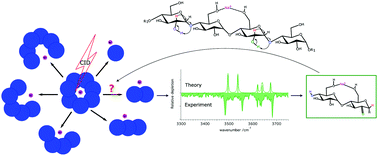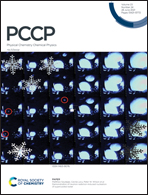Unravelling the structures of sodiated β-cyclodextrin and its fragments†
Abstract
We present cryogenic infrared spectra of sodiated β-cyclodextrin [β-CD + Na]+, a common cyclic oligosaccharide, and its main dissociation products upon collision-induced dissociation (CID). We characterize the parent ions using high-resolution ion mobility spectrometry and cryogenic infrared action spectroscopy, while the fragments are characterized by their mass and cryogenic infrared spectra. We observe sodium-cationized fragments that differ in mass by 162 u, corresponding to Bn/Zm ions. For the m/z 347 product ion, electronic structure calculations are consistent with formation of the lowest energy 2-ketone B2 ion structure. For the m/z 509 product ion, both the calculated 2-ketone B3 and the Z3 structures show similarities with the experimental spectrum. The theoretical structure most consistent with the spectrum of the m/z 671 ions is a slightly higher energy 2-ketone B4 structure. Overall, the data suggest a consistent formation mechanism for all the observed fragments.



 Please wait while we load your content...
Please wait while we load your content...